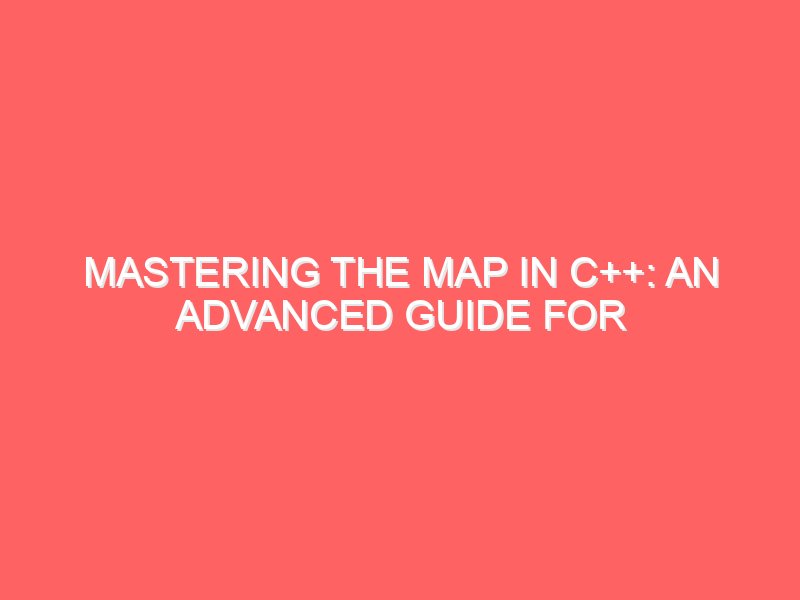Mastering the Map in C++: An Advanced Guide for Computer Science Students
Hey there, fellow tech enthusiasts! If you’re reading this, you’re probably already knee-deep in the world of C++. Kudos! Today, we’re diving into one of the most versatile and fascinating features of C++: the map container. So, grab your favorite caffeinated beverage and let’s embark on this journey together. Introduction to Maps in C++ Maps, often referred to as associative containers, are part of the Standard Template Library (STL) in C++. They allow you to store key-value pairs, where each key is unique, and each key is associated with exactly one value. Think of it as a dictionary in Python or an object in JavaScript, but with the power and speed of C++. In simple terms, a map is like a real-world dictionary where you look up a word (key) to find its meaning (value). But in the case of C++, these “words” can be any data type, not just strings. Here’s the syntax for declaring a map: For example, if you want a map that associates strings with integers (like a phone book): Pretty straightforward, right? Now, let’s dig deeper. Why Use Maps? Before we get our hands dirty with code, let’s answer the burning question: Why should you use maps? Declaring and Initializing Maps To declare a map, you need to include the <map> header. Here’s a quick rundown of how you can declare and initialize maps: Default Initialization Initializing with Values Using Iterators You can also initialize a map using iterators from another map or container: Basic Operations Now, let’s move on to some basic operations you can perform on maps. Inserting Elements You can insert elements into a map using the insert method or the [] operator. Accessing Elements To access elements, you can use the [] operator or the at method. Checking for Existence To check if a key exists in the map, use the find method or the count method. Removing Elements To remove an element from a map, use the erase method. Advanced Map Operations Alright, let’s level up our game with some advanced operations on maps. Custom Comparator By default, maps use the < operator to compare keys. However, you can define your own comparator to customize this behavior. Iterating Over Maps Iterating over maps can be done using iterators. Here’s a simple example: Range-based For Loop With C++11 and later, you can use the range-based for loop for easier iteration: Using Emplace for Efficient Insertion The emplace method constructs the key-value pair in place, potentially improving performance by avoiding unnecessary copies. Finding Lower and Upper Bounds Maps offer the lower_bound and upper_bound methods to find the range of keys. Performance Considerations Maps are powerful, but they come with performance considerations. Here are a few tips to keep in mind: Use Cases of Maps in Real-World Applications Maps are used in various applications, from simple lookup tables to complex algorithms. Here are some real-world examples: Database Indexing Maps are often used in databases to index data, allowing for fast retrieval based on keys. Caching Maps are ideal for implementing caches, where you store results of expensive computations for quick retrieval. Configuration Management Use maps to store configuration settings, enabling easy access and modification of parameters. Frequency Counting Count the frequency of elements in a dataset, such as word counts in a text document. Common Pitfalls and How to Avoid Them Even the best of us can make mistakes. Here are some common pitfalls when working with maps and how to avoid them: Uninitialized Maps Ensure that maps are initialized before use to avoid undefined behavior. Incorrect Key Types Use appropriate key types to avoid inefficient comparisons and unexpected behavior. Overusing Maps Maps are powerful, but not always the best choice. For simple collections, consider using vectors or sets. Ignoring Memory Overheads Monitor memory usage in applications with large maps to prevent memory-related issues. Conclusion Congratulations! You’ve made it through the advanced guide to maps in C++. Maps are an incredibly versatile tool in your C++ arsenal, capable of handling a variety of tasks efficiently. By mastering maps, you’re well on your way to becoming a C++ pro. Remember, practice makes perfect. Try implementing maps in your projects and experiment with different use cases. Happy coding! If you found this guide helpful, share it with your friends and fellow students. And don’t forget to check out our other courses and resources at Emancipation Edutech Private Limited. Until next time, keep coding and stay curious! Feel free to leave comments or questions below. We’re here to help you master C++ and more.
Mastering the Map in C++: An Advanced Guide for Computer Science Students Read More »

